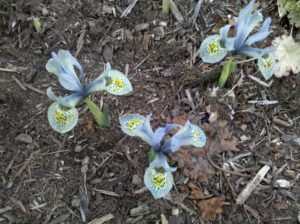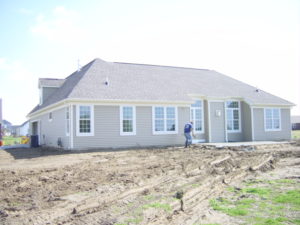My goal for 2017 is to simplify my time in the garden so I can actually enjoy it for a change.
This post contains affiliate links.
While my garden continues its long winter’s nap, I’m excited about the upcoming gardening season for the first time since 2012. Honestly, for the last five years, my garden has been in survival mode—as in what can survive with the absolute minimum of care. Becoming a mom in 2013 while working full-time drastically reduced my available gardening time, leaving my garden to largely fend for itself.

Iris reticulata in my garden– one of the first bulbs to bloom in very early spring, without any special coaxing from me!
Since I was a Horticulture Educator, it bothered me not having a lot of time for my garden. It was a lot like the old saying about the shoemaker’s children having no shoes– “she’s a horticulture educator and has a Ph.D. in horticulture; you’d think she could do something about her yard!”
What upset me, even more, was that I could feel myself enjoying my garden less and less each year— all I saw was a never-ending to-do list when I looked out in my yard, and I just kept falling further and further behind. My husband has valiantly done the lion’s share in keeping up with the garden, but what used to be something we enjoyed working on together has degenerated into an item on the “honey-do” list.
How did this happen?
In all honesty, becoming a mom was the tipping point for my garden. I was on thin ice keeping up with it for quite awhile, almost from the start. We bought our house in 2005. It was brand new construction, with nothing in the yard but the poor excuse for soil so common in new subdivisions. People said to me, “Oh this must be a dream come true for you as a horticulturist! A blank canvas!” I just smiled and nodded, but in reality I was pretty overwhelmed with the prospect.

Part of the “blank canvas” that gave me the cold sweats.
While it’s true that I have a Ph.D. in horticulture, it’s in plant breeding, not landscape design. I know a whole lot about plant genetics, am fascinated with the wide range of plant cultivars out there, and have a tendency to be a plant collector– this is not necessarily a good combination.
I did my best to map out planting beds, read up on basic landscape design, and made some really good plant choices. But I also made a really common mistake that I’m paying for 12 years later.
Too many plants for the space!
That first summer, my budget was small, and it seemed like I had endless empty space to fill. I tended to buy smaller sized plants because they were more affordable. As a result I did exactly what I had warned clients as an educator NOT to do– I ignored the spacing recommended on the label and planted everything way too close. This wasn’t noticeable for a few years, but as plants matured they got more and more crowded. This crowding outright killed a few plants, but mostly it just made maintenance a nightmare. Everything needed constant pruning to keep the garden looking neat.
The empty space also triggered my inner “plant hoarder/collector”. For example, I was always buying new cultivars of Coral Bells (Heuchera) and thyme. I had an entire bed devoted to thyme and two different beds of Heuchera! Several of these cultivars, although they were really unique in appearance, were extremely difficult to keep alive without constant intervention. Again, making maintenance a nightmare.
As we have expanded our garden in recent years, I’ve started to correct some of the overcrowding by moving plants. I’ve made note of what cultivars have died off and fought the urge to buy the latest cultivars until they’ve been around a few seasons (if I buy them at all).
Changing my approach
Back in early April 2013, I was enormously pregnant with my son while listening to horticulturist Felder Rushing’s keynote presentation at an event my office sponsored. I had started to correct some of my gardening mistakes at that point, but that spring I couldn’t do much of anything because my belly was in the way– my “to-do” list loomed in the back of my mind I was anxious about how I would garden once my bundle of joy arrived.
Felder’s presentation resonated with me– he was encouraging a more relaxed approach to gardening, which he called “Slow Gardening“. I jumped at the chance to buy the Slow Gardening book that day, and devoured it. Slow gardening invites us to appreciate the rhythm of the seasons, choose plants most appropriate for local conditions, and to sit back and actually ENJOY our gardens.
As much as the slow gardening concept seemed to be exactly what I was looking for, I have been my own worst enemy in putting in into practice. The garden “to-do” list is always tapping on my shoulder, interfering with enjoying the space.
My goal for 2017 is to fall in love with my garden again, rather than just see it as a never-ending “to-do” list. Since making the decision to leave full-time employment, gone are the weekends of trying desperately to catch up on garden chores, never finishing everything, leaving me discouraged and the list still not complete. I have more time available during the week now, but I still have two young children that always take priority over the garden. For my own sanity, I need to simplify my time in the garden, leaving me opportunities to sit back, enjoy and love my garden again.
I’ve been thinking about how to do this in 2017:
Streamline Watering
In 2011 I began using water absorbing polymers (a.k.a. “moisture control crystals”) in all my container gardens to minimize the need for daily/twice daily watering in the height of the summer. I also avoided planting pots smaller than about twelve inches in diameter unless I filled them with cacti or succulents. For the most part, this strategy worked wonderfully. With a couple of exceptions during the hottest of our heat waves, I didn’t need to spend hours watering each evening.
In 2017 my plan is to expand our use of drip irrigation beyond our vegetable garden. Simple systems that use a main ½” diameter hose with ¼” diameter tubing to particular plants or areas can be set up for under $50 for a small to medium size garden bed. I’m going to set up ours to water the potted plants on our patio. Just hook up the garden hose, and let the system do its job. If I attach a timer, I won’t even have to remember to turn on the water! Different size emitters on the ends of the ¼” tube deliver specific volumes of water to plants. Not only do I not have to individually water plants, drip irrigation uses less water and is more efficient than using a sprinkler or water wand. Less time spent watering plus a smaller water bill sounds great to me!
Fewer Containers
In 2013 after becoming a mom I dramatically reduced the number of containers I plant each spring. This sounds almost anti-gardening, but I quickly realized as a busy mom I barely have the time to plant the containers, let alone maintain them all. A few plants well cared for looks a lot better than dozens of neglected plants. I still plant a select few, but in the major locations with impact where I can enjoy them daily such as near our garage and outside my kitchen door on our patio. If I can get the drip irrigation set up as mentioned above, I will only have to worry about watering the containers near the garage. They are large “self-watering” containers with reservoirs in the bottom so they can go for a few days without watering.
Fewer Fussy Plants
A hidden benefit of neglecting so many things in the last five years is seeing what survived or even thrived without much care. One of the significant observations I’ve had of gardening in the previous five years is how much time I don’t have for fussy plants that need constant attention—just look for the big gaps where finicky plants used to live in my garden! I blame some of the fussy plant accumulation on the fact that I’m a sucker for new plant varieties. I haven’t met a gardener that isn’t to some degree.
Sometimes new colors, shapes, and sizes of a plant end up being less hardy and more delicate than conventional varieties. You can still satisfy your need for new plants by looking for newer varieties that have earned awards or performed well in test trials. Talk to employees at your local garden center, Extension staff or Master Gardeners. While you might not be the first person on the block with a new variety this way, you may be happier with the result.
Another strategy is to use more native plants. By nature, these plants are well-adapted to our climate and soils and so need relatively little attention once established. But do your homework and research before you plant; like any plant, some natives can be very aggressive growers, which may or may not be what you’d like for a particular area.
Garden with My Children
My son and daughter have been by my side in the garden from birth. Now this doesn’t mean I’ve checked off much of my to-do list while they’re “helping,” but what they have truly helped me do is slow down and enjoy the garden.
There is a section of our landscape that we planted years before becoming parents that we named “The Serenity Garden.” Our intent was to use the space for a slice of quiet solitude. But I never actually sat down in the space until I had my son in 2013.

Trying to take a family picture in our “Serenity Garden”. The Prince just turned 3, the Princess was exactly 2 weeks old that day– and it was our 10 year wedding anniversary! Photo: Josephine Leonard
I have vivid memories of sitting on the bench there in the shade of three river birches with my son when he was about six weeks old, refusing to nap, and eating non-stop. And there I was, in the throes of new parenthood, sleep deprived and not sure what I had gotten myself into. Sitting on that bench, watching the dappled patterns of the sunlight through the leaves calmed both of us. To this day we sit together on that same bench, and my daughter experienced the peace of that spot shortly after she was born in May.
As my inbox and mailbox fill with garden catalog offers for 2017, I feel hope instead of dread about my garden to-do list. I hope you’ll join me in simplifying your garden experience and finding new ways to enjoy your slice of paradise.
If you liked this post, please subscribe to Grounded and Growing today and receive your copy of “15 Tips to Become a '15 Minute Gardener'” so you can spend less time working ON your garden and more time enjoying being IN your garden.! It’s absolutely free. When you join the Grounded and Growing community, you’ll finally take the garden off your “To-Do” list and allow yourself time to enjoy your garden and savor the peace and serenity there. I tell subscribers about new posts as soon as I hit ‘publish’ and send weekly-ish updates on what’s going on in my garden– good, bad AND ugly.
Beautiful story, I’m interested in hearing more.
Thanks Karen! Stay tuned for more updates as I will add more posts about my efforts as the growing season unfolds– even if things don’t go as planned.
This is a great post Jen! We have only been in our house a few years and are left with a lot of landscaping that was not our choice. I’ve been overwhelmed at the thought of trying to make some of the empty garden space my own. Maybe this summer I can make it happen!
Thanks Steph! Hopefully as the season progresses I can give you some ideas on tackling projects in bite-size pieces. I’m trying to be patient with myself about this and I know it will be a challenge because the perfectionist in me tends to be very all or nothing. But to keep my sanity and get my garden where I want it, I need to work on it a little at a time.